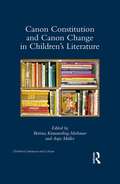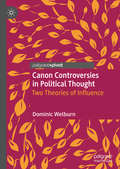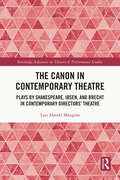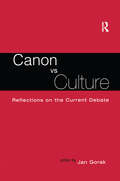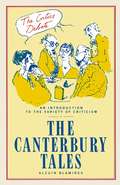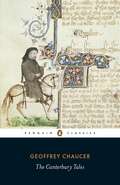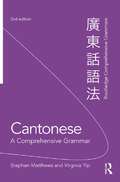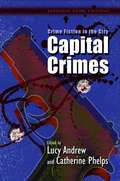- Table View
- List View
Canon Constitution and Canon Change in Children's Literature (Children's Literature and Culture)
This volume focuses on the (de)canonization processes in children’s literature, considering the construction and cultural-historical changes of canons in different children’s literatures. Chapters by international experts in the field explore a wide range of different children’s literatures from Great Britain, Germany, Scandinavia, the Low Countries, Eastern and Central Europe, as well as from Non-European countries such as Australia, Israel, and the United States. Situating the inquiry within larger literary and cultural studies conversations about canonicity, the contributors assess representative authors and works that have encountered changing fates in the course of canon history. Particular emphasis is given to sociological canon theories, which have so far been under-represented in canon research in children’s literature. The volume therefore relates historical changes in the canon of children’s literature not only to historical changes in concepts of childhood but to more encompassing political, social, economic, cultural, and ideological shifts. This volume’s comparative approach takes cognizance of the fact that, if canon formation is an important cultural factor in nation-building processes, a comparative study is essential to assessing transnational processes in canon formation. This book thus renders evident the structural similarities between patterns and strategies of canon formation emerging in different children’s literatures.
Canon Controversies in Political Thought: Two Theories of Influence
by Dominic WelburnThis book explores the meaning of 'influence', which has played a central role in the formation of the canon, or tradition, of Western political thought. Via a critical overview of the relative fortunes of influence studies in the history of political thought, literary theory, and – at times – the history of art and poetry, it is possible to identify a dominant theory of the term. Nietzschean and ‘emanational’ in nature, thanks largely to the work of Harold Bloom, this particular theory views influence as mere power and represents a broadly accepted meaning in twentieth century thought. Canons or traditions of thought came to be institutions in themselves reflecting prevalent social and political inequalities. To be sure, a theory of influence as power came to be seen as complicit in arbitrary canon formation, across a range of disciplines. The book argues, ultimately, that a second theory of influence, imported from Mary Orr’s work on intertextuality, affords a rival perspective and a more positive, intergenerational meaning of influence. Orr’s ‘braided rope’ theory of influence allows for the development of a plurality of canons each capable of constructing new histories for a variety of epistemic communities. The existence of agonistic, rival canons presents pedagogical questions for all teachers of political theory, but one that can be potentially navigated by a new understanding of influence, in the Orrian tradition.
The Canon in Contemporary Theatre: Plays by Shakespeare, Ibsen, and Brecht in Contemporary Directors’ Theatre (ISSN)
by Lars Harald MaagerøThis book explores the relationship between contemporary theatre, particularly contemporary theatre directors, and the dramatic canon of plays.Through focusing on productions of plays by three canonical playwrights (Shakespeare, Ibsen, and Brecht) by eight contemporary European directors (Michael Buffong, Joe Hill-Gibbins, and Emma Rice from the UK, Christopher Rüping from Germany, Thorleifur Örn Arnarsson from Iceland, and Kjeriski Hom, Alexander Mørk-Eidem, and Sigrid Strøm Reibo from Norway) the book investigates why and how the theatre continues to engage with canonical plays. In particular, the book questions the political and cultural implications of theatrical reproductions of the literary canon. Drawing on Chantal Mouffe’s theories of agonism and ‘critical art,’ the book investigates whether theatrical reproduction of the canon always reconstitutes the hegemonic values and ideologies of the canon, or whether theatrical interventions in the canon can challenge such values and ideologies, and thereby also challenge the dominant ideologies and hegemonies of contemporary culture and society.This study will be of great interest to academics and students in drama and theatre, particularly those who work with theatre in the twenty-first century, directors’ theatre, and the political impact of theatre.
The Canon in Contemporary Theatre: Plays by Shakespeare, Ibsen, and Brecht in Contemporary Directors’ Theatre (ISSN)
by Lars Harald MaagerøThis book explores the relationship between contemporary theatre, particularly contemporary theatre directors, and the dramatic canon of plays.Through focusing on productions of plays by three canonical playwrights (Shakespeare, Ibsen, and Brecht) by eight contemporary European directors (Michael Buffong, Joe Hill-Gibbins, and Emma Rice from the UK, Christopher Rüping from Germany, Thorleifur Örn Arnarsson from Iceland, and Kjeriski Hom, Alexander Mørk-Eidem, and Sigrid Strøm Reibo from Norway) the book investigates why and how the theatre continues to engage with canonical plays. In particular, the book questions the political and cultural implications of theatrical reproductions of the literary canon. Drawing on Chantal Mouffe’s theories of agonism and ‘critical art,’ the book investigates whether theatrical reproduction of the canon always reconstitutes the hegemonic values and ideologies of the canon, or whether theatrical interventions in the canon can challenge such values and ideologies, and thereby also challenge the dominant ideologies and hegemonies of contemporary culture and society.This study will be of great interest to academics and students in drama and theatre, particularly those who work with theatre in the twenty-first century, directors’ theatre, and the political impact of theatre.
Canon Vs. Culture: Reflections on the Current Debate (Wellesley Studies in Critical Theory, Literary History and Culture)
by Jan GorakCanon Vs. Culture explores the consequences of one of the main educational shifts of the last quarter century-- the changes from academic inquiry conducted through a selected list of accepted authorities to an investigation of the cultural operations of an entire society.
Canon Vs. Culture: Reflections on the Current Debate (Wellesley Studies in Critical Theory, Literary History and Culture)
by Jan GroakCanon Vs. Culture explores the consequences of one of the main educational shifts of the last quarter century-- the changes from academic inquiry conducted through a selected list of accepted authorities to an investigation of the cultural operations of an entire society.
Canonizing Hypertext: Explorations and Constructions (Continuum Literary Studies)
by Astrid EnsslinThis innovative monograph focuses on a contemporary form of computer-based literature called 'literary hypertext', a digital, interactive, communicative form of new media writing. Canonizing Hypertext combines theoretical and hermeneutic investigations with empirical research into the motivational and pedagogic possibilities of this form of literature. It focuses on key questions for literary scholars and teachers: How can literature be taught in such a way as to make it relevant for an increasingly hypermedia-oriented readership? How can the rapidly evolving new media be integrated into curricula that still seek to transmit 'traditional' literary competence? How can the notion of literary competence be broadened to take into account these current trends? This study, which argues for hypertext's integration in the literary canon, offers a critical overview of developments in hypertext theory, an exemplary hypertext canon and an evaluation of possible classroom applications.
Canons and Contexts
by Paul LauterThis collection of essays places issues central to literary study, particularly the question of the canon, in the context of institutional practices in American colleges and universities. Lauter addresses such crucial concerns as what students should read and study, how standards of "quality" are defined and changed, the limits of theoretical discourse, and the ways race, gender, and class shape not only teaching, curricula, and research priorities, but collegiate personnel actions as well. The book examines critically the variety of recent proposals for "reforming" higher education, and it calls into question many practices, like employing large numbers of part-timers, now popular with college managers. Offering concrete examples of a "comparative" method for teaching literary texts, and specific instances about "integrating" curricula, Canons and Contexts proposes realistic ideas for creating varied, spirited, and democratic classrooms and colleges.
The Canterbury Tales
by Geoffrey ChaucerAt the Tabard Inn in Southwark, a jovial group of pilgrims assembles, including an unscrupulous Pardoner, a noble-minded Knight, a ribald Miller, the lusty Wife of Bath, and Chaucer himself. As they set out on their journey towards the shrine of Thomas a Becket in Canterbury, each character agrees to tell a tale. The twenty-four tales that follow are by turns learned, fantastic, pious, melancholy and lewd, and together offer an unrivalled glimpse into the mind and spirit of medieval England.
The Canterbury Tales
by Derek PearsallThis classic and eminently readable work provides a full critical introduction to the complete Canterbury Tales. Essential reading for students of Chaucer.
The Canterbury Tales
by Derek PearsallThis classic and eminently readable work provides a full critical introduction to the complete Canterbury Tales. Essential reading for students of Chaucer.
Cantonese: A Comprehensive Grammar
by Stephen Matthews Virginia YipCantonese: A Comprehensive Grammar is a complete reference guide to Cantonese as spoken by native speakers in Hong Kong. It presents a fresh and accessible description of the language, concentrating on the real patterns of use in current Cantonese. This makes it the ideal reference source for all learners and users of Cantonese, irrespective of level, in schools, colleges, universities and adult classes of all types. Moreover, it will provide a lasting and reliable resource for all fluent speakers of the language. The book is organized to promote a thorough understanding of Cantonese grammar. Arranged by both syntactic categories and language functions, the Grammar provides an in-depth treatment of structures and pays special attention to idiom and speech registers. Explanations are full, clear and free of jargon. An extensive index, numbered paragraphs and generous use of headings and cross-references provide readers with easy access to the information they require. Features include: Comprehensive pronunciation section Full use of examples from films, advertising and authentic conversations Cantonese-English parallels highlighted throughout the book All examples given in characters as well as pinyin
Cantonese: A Comprehensive Grammar
by Stephen Matthews Virginia YipCantonese: A Comprehensive Grammar is a complete reference guide to Cantonese as spoken by native speakers in Hong Kong. It presents a fresh and accessible description of the language, concentrating on the real patterns of use in current Cantonese. This makes it the ideal reference source for all learners and users of Cantonese, irrespective of level, in schools, colleges, universities and adult classes of all types. Moreover, it will provide a lasting and reliable resource for all fluent speakers of the language. The book is organized to promote a thorough understanding of Cantonese grammar. Arranged by both syntactic categories and language functions, the Grammar provides an in-depth treatment of structures and pays special attention to idiom and speech registers. Explanations are full, clear and free of jargon. An extensive index, numbered paragraphs and generous use of headings and cross-references provide readers with easy access to the information they require. Features include: Comprehensive pronunciation section Full use of examples from films, advertising and authentic conversations Cantonese-English parallels highlighted throughout the book All examples given in characters as well as pinyin
Cantonese as a Second Language: Issues, Experiences and Suggestions for Teaching and Learning (Routledge Studies in Applied Linguistics)
Cantonese is a language from southern China that is spoken by roughly 70 million people worldwide. It is the language of Hong Kong cinema and has traditionally been the most prominent language spoken in Chinatowns around the world. People choose to learn Cantonese for a variety of social and economic reasons: because it is a heritage language that one’s relatives speak; because it is the language of one’s partner and monolingual in-laws; because it is necessary for living and working in Hong Kong, Macau, Guangzhou, or other Cantonese-speaking communities; because it is the bridge to fully appreciating and understanding Cantonese culture; or simply because it is an irresistible challenge. Whatever the motivation, more and more people are choosing to learn Cantonese as an additional language. This book discusses many issues related to both acquiring and teaching Cantonese. If you are a learner of Cantonese, this long overdue volume is essential to understanding both the grammatical and the social issues involved with learning this notoriously difficult language. If you are a teacher, this book will be invaluable to gaining insight into your students’ motivations and needs. And finally, if you are an applied linguist, the unique aspects related to the acquisition of Cantonese offer a fascinating contribution to the literature.
Cantonese as a Second Language: Issues, Experiences and Suggestions for Teaching and Learning (Routledge Studies in Applied Linguistics)
Cantonese is a language from southern China that is spoken by roughly 70 million people worldwide. It is the language of Hong Kong cinema and has traditionally been the most prominent language spoken in Chinatowns around the world. People choose to learn Cantonese for a variety of social and economic reasons: because it is a heritage language that one’s relatives speak; because it is the language of one’s partner and monolingual in-laws; because it is necessary for living and working in Hong Kong, Macau, Guangzhou, or other Cantonese-speaking communities; because it is the bridge to fully appreciating and understanding Cantonese culture; or simply because it is an irresistible challenge. Whatever the motivation, more and more people are choosing to learn Cantonese as an additional language. This book discusses many issues related to both acquiring and teaching Cantonese. If you are a learner of Cantonese, this long overdue volume is essential to understanding both the grammatical and the social issues involved with learning this notoriously difficult language. If you are a teacher, this book will be invaluable to gaining insight into your students’ motivations and needs. And finally, if you are an applied linguist, the unique aspects related to the acquisition of Cantonese offer a fascinating contribution to the literature.
Cantonese Particles and Affixal Quantification (Studies in Natural Language and Linguistic Theory #87)
by Peppina Po-lun LeeCantonese, the lingua franca of Hong Kong and its neighboring province, has an unusually rich repertoire of verbal particles. This volume significantly augments the academic literature on their semantics, focusing on three affixal quantifiers, -saai, -hoi and -maai. The author shows how these verbal suffixes display a unique interplay of syntax and semantics: used in a sentence with no focus, they quantify items flexibly, according to an accessibility hierarchy; with focus, focus comes into effect after syntactic selection. This fresh and compelling perspective in the study of particles and quantification is the first in-depth analysis of Cantonese verbal suffixes. It compares the language’s affixal quantification to the alternative determiner and adverbial quantifiers. The book’s syntax-semantics mapping geography deploys both descriptive and theoretical approaches, making it an essential resource for researchers studying the nexus of syntax and semantics, as well as Cantonese itself.
Canvas
by Michael WynneJustine and Alan need to get away from it all. And what better way than camping on a farm in the Welsh countryside? So long as that's camping with all the luxuries, of course: real beds, wood burning stoves and an espresso machine. Sharing the rural idyll are seasoned campers Bridget and Rory, upwardly mobile Amanda and Alistair and a bunch of offspring. But canvas walls and adjacent tents leave little to the imagination in this entertaining exposé of modern family life. Michael Wynne's Canvas premiered at the Minerva Theatre, Chichester, in May 2012.
Cape (Plays for Young People)
by Inua EllamsIt's a simple idea, really. 1. Wear a uniform; 2. Protect who you love, what you care about; 3. Let nothing get in your way.Someone mugged Bruce's mum and he is not having it. The shock is still visible in her trembling fingers, rippling out across the calm waters of their lives. He grabs his hoodie, his uniform, his cape and goes out to find the culprit. Smithy wants everyone to stay inside, Uhuru wants everyone out. Tanya thinks it's boyish fun and games until, very suddenly, it isn't.Inua Ellams's play questions the boundaries between our right to self-defense and taking the law into our own hands. Told with five roles spanning from young people to adults, it deals with themes that young people face today: the role of boundaries and what happens when someone 'crosses the line'; fear and the use of self-defense; and examining different perspectives on a situation.Originally commissioned by Synergy Theatre Project Cape premiered at London's Unicorn Theatre in 2013 and went on to tour schools, prisons and a young offender institution. This new edition, published within Methuen Drama's Plays For Young People series features notes for teachers and exercises for students for practical use in the classroom.
Cape (Plays for Young People)
by Inua EllamsIt's a simple idea, really. 1. Wear a uniform; 2. Protect who you love, what you care about; 3. Let nothing get in your way.Someone mugged Bruce's mum and he is not having it. The shock is still visible in her trembling fingers, rippling out across the calm waters of their lives. He grabs his hoodie, his uniform, his cape and goes out to find the culprit. Smithy wants everyone to stay inside, Uhuru wants everyone out. Tanya thinks it's boyish fun and games until, very suddenly, it isn't.Inua Ellams's play questions the boundaries between our right to self-defense and taking the law into our own hands. Told with five roles spanning from young people to adults, it deals with themes that young people face today: the role of boundaries and what happens when someone 'crosses the line'; fear and the use of self-defense; and examining different perspectives on a situation.Originally commissioned by Synergy Theatre Project Cape premiered at London's Unicorn Theatre in 2013 and went on to tour schools, prisons and a young offender institution. This new edition, published within Methuen Drama's Plays For Young People series features notes for teachers and exercises for students for practical use in the classroom.
Capetian Women (The New Middle Ages)
by K. NolanNever before have the women of the Capetian royal dynasty in France been the subject of a study in their own right. The new research in Capetian Women challenges old paradigms about the restricted roles of royal women, uncovering their influence in social, religious, cultural and even political spheres. The scholars in the volume consider medieval chroniclers' responses to the independent actions of royal women as well as modern historians' use of them as vehicles for constructing the past. The essays also delineate the creation of reginal identity through cultural practices such as religious patronage and the commissioning of manuscripts, tomb sculpture, and personal seals.
Capital (The Macat Library)
by Macat TeamA critical analysis of Karl Marx’s Capital, which is without question one of the most influential books to be published in the course of the past two centuries. Controversial in its politics, and arriving at conclusions that are passionately debated to this day, it is nonetheless a fine example of the creative combination of a philosophical method (the dialectic) with historical and economic information to produce a new interpretation of history. Capitalism, thought Marx, works by exploiting the working class. Their wages do not reflect the value of their labor. Marx concluded that capitalism would fail because of this contradiction at the heart of the capitalist system. He wrote Capital to give activists the theories and language they needed to criticize the system. But the work also outlines the new communist society that Marx hoped would rise in its place, and it helped to inspire the rise of states that largely shaped the modern history of our planet. Today, after a century of conflict, Marx’s analysis still offers valuable tools that help us analyze the modern world. Marx's belief that he had arrived at a scientific way of describing the present and predicting the future may not be shared by many of his modern interpreters. But his ability to connect things together in new ways is not in doubt – and nor is the influence of the new hypotheses that he generated as a result of so much careful analysis.
Capital, Commodity, and English Language Teaching (Language, Society and Political Economy)
by William SimpsonCapital, Commodity, and English Language Teaching illustrates how the drive for profit in commercial ELT affects the manner in which language is taught. The book looks at education as a form of production, and asks how lessons are produced, and how the production of profit in addition to the production of the lesson affects the operation of educational institutions and their stakeholders. Simpson delivers a theoretically rigorous conception of capital and builds from this an investigation into how the circulation of capital for profit interrelates with the teaching of language. Simpson discusses ELT at both a global level, in discussion of the ELT industry in the UK, the US, Ireland, Canada, Japan, Spain, and transnationally online, as well as at a more local level, where finer detailed descriptions of the work-lives of those within the Japanese eikaiwa ELT industry are given. Drawing on a synthesis of Marxist and Bourdieusian theory, the book outlines a dialectical approach to understanding capital, and to understanding how the drive for profit and language education interrelate with one another. Simpson concludes by showing how such an approach might open up areas for further research in a number of contexts across the globe, as well as in light of the Covid-19 pandemic. Providing a model for addressing global issues of ELT, this book is of interest to advanced students, scholars and professionals within applied linguistics, TESOL, sociolinguistics, and linguistic anthropology, language economics and related areas.
Capital, Commodity, and English Language Teaching (Language, Society and Political Economy)
by William SimpsonCapital, Commodity, and English Language Teaching illustrates how the drive for profit in commercial ELT affects the manner in which language is taught. The book looks at education as a form of production, and asks how lessons are produced, and how the production of profit in addition to the production of the lesson affects the operation of educational institutions and their stakeholders. Simpson delivers a theoretically rigorous conception of capital and builds from this an investigation into how the circulation of capital for profit interrelates with the teaching of language. Simpson discusses ELT at both a global level, in discussion of the ELT industry in the UK, the US, Ireland, Canada, Japan, Spain, and transnationally online, as well as at a more local level, where finer detailed descriptions of the work-lives of those within the Japanese eikaiwa ELT industry are given. Drawing on a synthesis of Marxist and Bourdieusian theory, the book outlines a dialectical approach to understanding capital, and to understanding how the drive for profit and language education interrelate with one another. Simpson concludes by showing how such an approach might open up areas for further research in a number of contexts across the globe, as well as in light of the Covid-19 pandemic. Providing a model for addressing global issues of ELT, this book is of interest to advanced students, scholars and professionals within applied linguistics, TESOL, sociolinguistics, and linguistic anthropology, language economics and related areas.
Capital Crimes: Crime Fiction In The City (International Crime Fictions)
by Lucy Andrew Catherine PhelpsCrime Fiction in the City: Capital Crimes expands upon previous studies of the urban space and crime by reflecting on the treatment of the capital city, a repository of authority, national identity and culture, within crime fiction. This wide-ranging collection looks at capital cities across Europe, from the more traditional centres of power - Paris, Rome and London - to Europe's most northern capital, Stockholm, and also considers the newly devolved capitals, Dublin, Edinburgh and Cardiff. The texts under consideration span the nineteenth-century city mysteries to contemporary populist crime fiction. The collection opens with a reflective essay by Ian Rankin and aims to inaugurate a dialogue between Anglophone and European crime writing; to explore the marginalised works of Irish and Welsh writers alongside established European crime writers and to interrogate the relationship between fact and fiction, creativity and criticism, within the crime genre.
